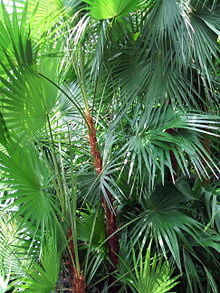Acoelorrhaphe

e710Acoelorrhaphe is a genus of palms with single species Acoelorrhaphe wrightii, known as the Paurotis palm, Everglades palm or Madeira palm in English[2][3][4][5] and cubas, tique, and papta in Spanish.[6]
It is native to Central America, southeastern Mexico, the Caribbean, Colombia, the Bahamas, and extreme southern Florida where it grows in swamps and periodically flooded forests. It is a small to moderately tall palm that grows in clusters to 5–7 metres (16–23 ft), rarely 9 m (30 ft) tall, with slender stems less than 15 centimetres (5.9 in) diameter. The leaves are palmate (fan-shaped), with segments joined to each other for about half of their length, and are 1–2 m (3.3–6.6 ft) wide, light-green above, and silver underneath. The leaf petiole is 1–1.2 m (3.3–3.9 ft) long, and has orange, curved, sharp teeth along the edges. The flowers are minute, inconspicuous and greenish, with 6 stamens. The trunk is covered with fibrous matting. The fruit is pea-sized, starting orange and turning to black at maturity.[7][8]
The genus name is often cited as Acoelorraphe,[7][9] a spelling error to be corrected under the provisions of the ICBN. The genus name is a combination of three Greek words meaning a- ‘without’, koilos ‘hollow’, and rhaphis ‘needle’, an allusion to the form of the fruit. The species is named after the American botanist Charles Wright.[10]
